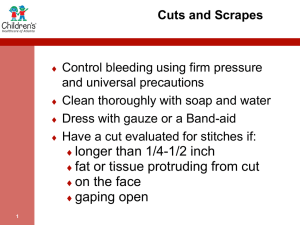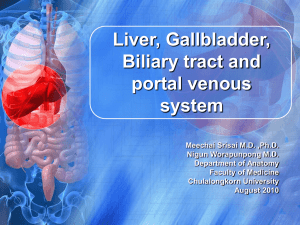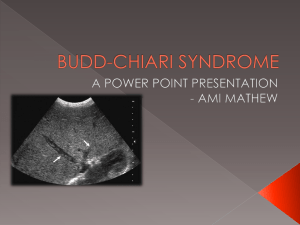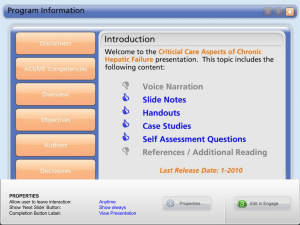Complex Hepatic Injuries
advertisement
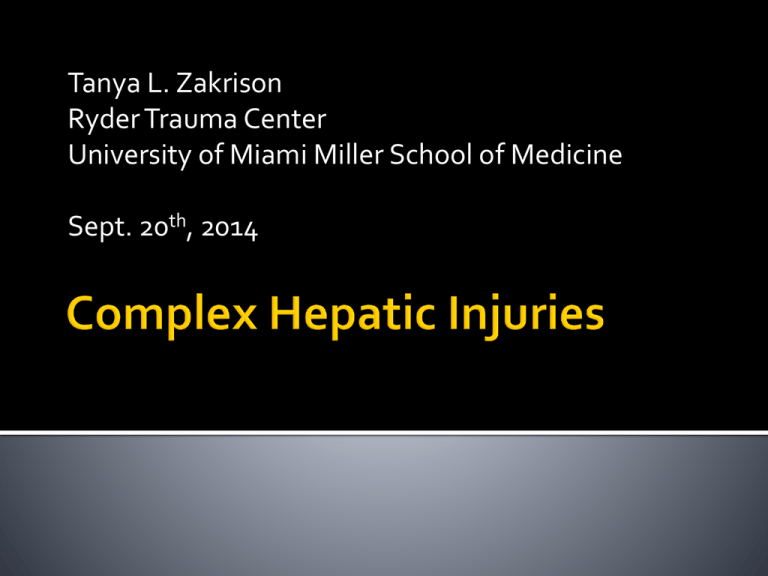
Tanya L. Zakrison Ryder Trauma Center University of Miami Miller School of Medicine Sept. 20th, 2014 18 male helmeted patient, high speed motorcycle collision Thrown off motorcycle hits barrier EMS arrives Patient is unresponsive, significant blunt trauma to right torso, blood pressure 80/50 mmHg Pre-hospital care most important is prompt transportation to a trauma center ▪ SCOOP AND RUN A - Intubate (possibly) B - Needle decompression for any concern about a tension pneumothorax Circulation – IV access, hypotensive resuscitation? D – TBI with spinal cord injury – probable Exposure ATLS protocol in the trauma bay Work as a team, excellent communication Repeat the ABCDEs Verify ETT placement Help the surgeons place a tube thoracostomy on decompressed side ▪ Contralateral side too if still hypotensive Verify that the IV sites are in place, 20 cc/kg crystalloid ▪ Blood (massive transfusion protocol) ED thoracotomy? FAST & CXR Do we need to operate or not? Diasylate fluid is infused intraperitoneally to increase intra-abdominal pressure to reduce bleeding in the pre-hospital phase Compared to previous models of abdominal hypertension using CO2 insufflation Animal model demonstrated efficacy in animal models of liver injury Abdominal pressure of 15 mmHg achieved Mean arterial pressure, hematocrit and glucose concentration higher in dialysate group Adjunct to increase survival in the pre-hospital phase Hemodynamically stable Blunt Penetrating Hemodynamically unstable Blunt Penetrating Specific injuries: Parenchymal injuries Grade V juxtahepatic venous injuries Portal triad Complications There are 4 sources of bleeding in the liver Falciform ligament Ligamentum teres Coronary ligaments Triangular ligaments Hematomas may be contained within suspensory ligaments May injure: Blood vessels: ▪ ▪ ▪ ▪ Retrohepatic IVC Hepatic veins Portal veins Hepatic arteries Management options: Bleeding & Air embolism Biliary radicles Parenchyma Perihepatic structures Packing Direct suture Finger fracture Omental packing Penetrating tract ▪ Open it (tractotomy) ▪ Pack it (multiple adjuncts) Hemostatic agents Liver bag Vascular isolation Atriocaval shunting Resection & tranplantation Veno-veno bypass 85% of pts. with blunt liver injury are stable 89% of these are managed non-operatively ▪ Majority venous blood supply to liver (low pressure) Non-operative management (NOM) leads to: Less transfusions of blood products Decreased length of stay Decreased infectious complications Few contraindications to NOM Must be hemodynamically stable Failure in 14% grade IV injuries, 23% grade V Role for non-operative management Renz et al. (1994): ▪ NOM in 13 pts. with TA GSWs ▪ Follow with serial PE’s, contrast-enhanced CT scans Demetriades et al. (1999): ▪ NOM in 16 pts. with TA GSWs ▪ Failure of NOM 33% Omoshoro-Jones et al. (2005): ▪ NOM in 31/33, including pts. with grade V liver injuries ▪ Most complications also treated non-operatively Ultimately only 30% of penetrating hepatic trauma will be eligible for NOM Pt. selection important: HD stability GCS = 15 no peritonitis no active bleed on CT AAST grade does not determine eligibility for NOM Angioembolization (AE): Pseudoaneurysm, blush, active extravasation May be used in NOM, pre-op. or post-op. Asensio et al. (2003 & 2007) Early hepatic AE in all pts. with grades IV, V injuries Improved survival with ▪ Immediate surgery ▪ Early hepatic packing ▪ Direct pt. transport from OR to angio suite Classic teaching is operative management Operative principles: Hemostasis Debridement Adequate exposure Drainage Results poor with severe, high grade injuries (V) Traditional operative approach being revised Multidisciplinary approach also advocated by some in unstable patients Diagnostic & therapeutic maneuvres Pack – what is bleeding? Pringle maneuver (1908) ▪ Hepatic arterial bleeding ▪ Portal venous bleeding ▪ May use safely for up to 75 minutes If ongoing venous bleeding with pringle maneuvre Retrohepatic IVC Major hepatic veins Direct visualization of bleeding vessels to suture ligate Even if need to divide uninjured parenchyma ▪ Tractotomy ▪ Finger fracture In severe injuries, vascular exclusion / isolation techniques may be used Atriocaval shunt Complete vascular inflow occlusion ▪ ▪ ▪ ▪ Pringle Aorta Infrahepatic IVC Suprahepatic IVC May resort to venoveno bypass Allows for direct repair of injuries juxtahepatic venous injuries Onset of triad of death Extensive bilobar injuries Large, expanding or ruptured hematomas 4. Failure of other maneuvers 5. Pts. who require transfer to a level I trauma center 6. Juxtahepatic venous injuries Watch IVC with packing Remove < 72 hrs 1. 2. 3. Retrohepatic IVC 7 cms in length Phrenic & right adrenal vein Completely circumscribed by hepatic suspensory ligaments Major hepatic veins Right, middle, left Supernumerary veins Typically 7, additional smaller veins Drain right and caudate lobes RIVC & MHVs are resistant to collapse or compression Most deadly form of liver trauma Non-compressible, do not collapse Surgically inaccessible Injury causes Life-threatening exsanguination Fatal air embolism Poor outcomes may be due to Lack of familiarity with anatomy Limited surgical experience Current management strategies are flawed Elements of injury include: Direct injury to vein Intraparenchymal Extraparenchymal Injury to surrounding tamponading tissues Parenchyma & capsule (intraparenchymal) Areolar tissue, diaphragm, hepatic suspensory ligaments Free bleeding occurs IFF there is a breach in the containing tissues in association with a venous injury These breaches may occur with surgical decompression which can lead to massive, uncontrollable free bleeding Hepatic venous injury is intraparenchymal Associated disrupted liver parenchyma and capsule Injuries bleed directly through disrupted liver parenchyma May have associated injury to portal veins or hepatic arteries Venous wound is extraparenchymal Associated disruption of suspensory ligaments, diaphragm or both Bleeding mainly Around the liver Into chest Much less common than type A Amount of free bleeding depends on: Extent of venous laceration Severity of injury of associated structures Operative strategies: Direct suture repair +/- vascular isolation Lobar resection for bleeding control Tamponade / containment of venous bleeding Direct repair done in accordance with historic beliefs, approach taken elsewhere in body Ochsner (1961) & Starzl (1962) pioneers for repair of IVC injuries Infrahepatic IVC injuries, none were retrohepatic Technical difficulties lead to vascular exclusion / isolation techniques as adjuncts Atriocaval shunt (Schrock – 1968) ▪ First successful suture of JHVI Bricker, 1971 Complete vascular exclusion (Waltuck – 1970, Yellin – 1971) ▪ Clamps applied to the suprahepatic and infrahepatic IVC, portal vein, aorta ▪ Prohibitively high rate of cardiac arrest if done while pt. severely hypovolemic Need for venous suturing has never been questioned McClelland & Shires (1965) 80% survival in 25 pts. undergoing lobectomy for severe hepatic trauma Unclear prevalence of JHVI Other series demonstrate high mortality when done for bleeding or precise anatomic resection Main success is with debridement for devitalized tissues Not widely applied for treatment of acute hemorrhage from hepatic venous injury Complete resection = hepatic transplantation Few successes in case reports Deep parenchymal suturing to control venous bleeding ‘standard of care’ Stone & Lamb (1975) Omental inclusion with deep sutures Near complete success in 37 pts. Fabian & Stone (1980) 104 pts. with blunt hepatic injury & venous bleeding Hemostasis in 95%, 8% died Repeat study in 1991 with JHVI ▪ Survival 80% Mortality 3x lower vs. direct venous repair +/- isolation Ideal for type A injuries Beal (1990) Perihepatic gauze packing in 35 pts. including JHVI Mortality 14% vs. 70% with AC shunts & DVR Balloon tamponade used in bilobar GSWs Very few with actual hepatic venous injury Wide hepatic mobilization & direct venous ligation should be abandoned for JHVIs Omental and gauze packing provide alternatives with lower mortality Recurrence of bleeding or thrombosis are not major sources of mortality when veins are not repaired Based on injury pattern, restoration of containment structures around disrupted veins may be a preferred approach Can we improve how we pack? Hemostatic agents prepacking? Packing material itself? New multimodality approaches Endovascular stenting of IVC Intraoperative percutaneous deployment of venous balloons ▪ Right femoral vein to infrahepatic IVC ▪ Right internal jugular to retrohepatic IVC ▪ Proceed with suture repair of venous injuries FloSeal may be applied to actively bleeding vessels. Made of bovine gelatin & thrombin, hemostasis occurs in wet fields up to arterial pressure FloSeal effectively stopped hemorrhage in arterial & venous injuries (IV, V) in coagulopathic swine. Leixnering M., et al., J Trauma, 64 (2), 2008 Modified chitosan (N-acetyl glucosamine) used in an animal model of liver injury Grade V major hepatic venous involvement Animals also coagulopathic & hypothermic MC group: Higher MAP Less total blood loss All MC animals survived 50% controls died Bochicchio G. et al, Use of a modified chitosan dressing in a hypothermic, coagulopathic grade V liver injury model, American Journal of Surgery (2009) 198, 617–622 Portal vein Mainly seen with penetrating injuries May ligate portal vein ▪ Fluid requirements massive ▪ Second look laparotomy for small bowel viability ▪ Splenectomy? Proper hepatic artery May ligate with impunity ▪ Holds true for normotensive pts., pts. in shock may experience hepatic necrosis Common bile duct High rate of failure & stenosis with primary end-to-end anastomosis Roux-en-Y hepaticojejunostomy preferred ▪ Drain & refer to specialized hepatobiliary surgeon Abscesses Bilomas Necrosis Pseudoaneurysms Hemobilia: blood (arterial) into bile Quincke (1871): RUQ pain, jaundice, UGIB Treat with ERCP, angioembolization or OR if fails Bilhemia: bile into blood (venous) Presence of hyperbilirubinemia, normal LFT’s Treat with ERCP Thoracobiliary fistula: bile into pleura May progress to bronchobiliary fistula Treat with chest tube & ERCP Grade V hepatic injury? Consider injury pattern Consider a different approach Consider new adjuncts ▪ FloSeal (gelatin bovine & thrombin) ▪ Modified chitosan packs ▪ Angioembolization Watch for complications tzakrison@med.miami.edu ¡Muito obrigado!


